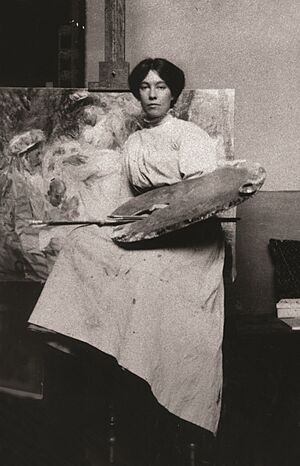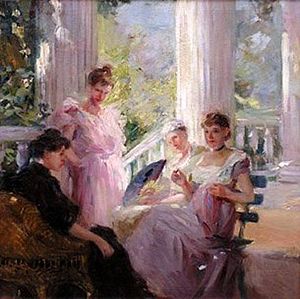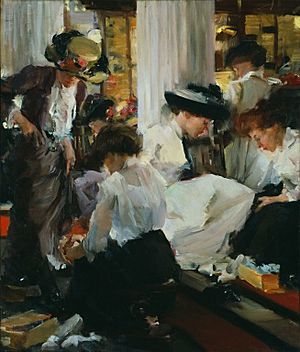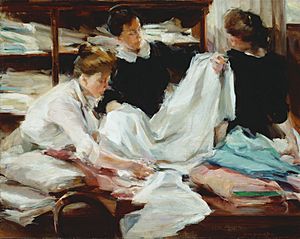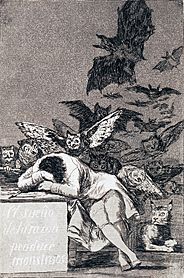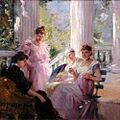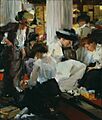Elizabeth Sparhawk-Jones facts for kids
Quick facts for kids
Elizabeth Sparhawk-Jones
|
|
|---|---|
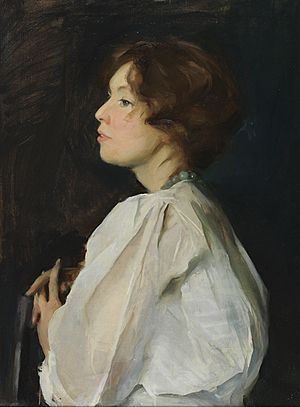
1910 portrait by Alice Kent Stoddard
|
|
| Born |
Elizabeth Huntingdon Jones
November 8, 1885 |
| Died | December 26, 1968 (aged 83) Connecticut, U.S.
|
| Resting place | Immanuel Episcopal Church cemetery, Sparks, Maryland, U.S. |
| Education |
|
|
Notable work
|
|
| Awards |
|
Elizabeth Sparhawk-Jones (born Elizabeth Huntingdon Jones; November 8, 1885 – December 26, 1968) was an American painter. She lived in New York City, Philadelphia, and Paris, France. Elizabeth had a very successful career as an artist in the early 1900s. Her paintings were shown all over the world, and she won many awards.
Later, she faced a difficult time with her health, which paused her career. But she came back strong, creating beautiful modern watercolor paintings. Elizabeth also spent time at special places called artist colonies. There, she lived and worked alongside famous artists, writers, and musicians. Today, her artworks are displayed in major American art museums. These include the Art Institute of Chicago, Metropolitan Museum of Art, and Museum of Modern Art.
Contents
Elizabeth's Early Life and Family
Growing Up and Discovering Art
Elizabeth Huntingdon Jones was born on November 8, 1885. Her father, Rev. John Sparhawk Jones, was a church leader. Her mother, Harriet Sterett Winchester, came from a well-known family in Maryland. The family lived in Baltimore until 1890, then moved to Philadelphia.
Elizabeth's mother was a strong woman. Yet, she believed in letting her children explore their talents. She introduced Elizabeth and her sister Margaret to classic books. Both parents encouraged Elizabeth's interest in art. She started drawing around age seven. As a child, she won first place in a national art contest. Around age 15, she left school to attend the Pennsylvania Academy of the Fine Arts (PAFA).
Challenges and Changes
Elizabeth had a close connection with Morton Livingston Schamberg. He was a fellow artist and student at PAFA. Her parents did not approve of this relationship. In 1906, they convinced her to turn down a special scholarship. This scholarship would have sent her to Paris for two years. Her relationship with Schamberg then ended.
In 1907, Elizabeth changed her name to Elizabeth Sparhawk-Jones. She did this to honor her father's mother. In 1910, her father died while the family was on vacation. Her sister Margaret got married in Paris in 1913. This was against their mother's wishes. Elizabeth's mother pressured her to take her side. This caused a difficult relationship between the sisters for many years. Elizabeth also felt very tired from her art career. Family money problems added to her stress.
Facing Mental Health Challenges
Like her father, Sparhawk-Jones struggled with sadness. When she felt unwell, she sometimes burned her paintings. This meant fewer of her artworks were available. In 1913, Elizabeth had a mental health crisis. She lived in the Pennsylvania Hospital for the Insane for three years. This experience was very hard on her. She felt scared and alone during that time.
After leaving the hospital in 1916, she moved in with her mother. She also dealt with the loss of her teacher, William Merritt Chase, who died in 1916. Morton Schamberg, her former friend, died in 1918. Elizabeth later said she did not work as an artist for about 12 years.
Elizabeth's Connections and Homes
Friendships with Writers and Artists
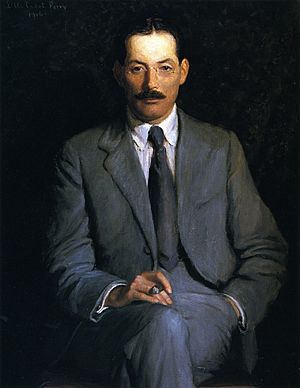
Sparhawk-Jones enjoyed spending time with writers more than other artists. She loved living at artist retreats. Places like MacDowell Colony and Yaddo had writers, musicians, and artists living there. Edwin Arlington Robinson (1868–1935) was a poet who won the Pulitzer Prize. He and Sparhawk-Jones visited the MacDowell Colony at the same times for about ten years. They had a special friendship. After he died, Elizabeth painted several artworks in his memory. She described him as a kind and thoughtful man.
Sparhawk-Jones was also friends with Nancy Cox-McCormack and Marsden Hartley. She was known for her humor and cleverness. However, in an interview in 1964, she said she often felt lonely. She preferred a quiet way of life.
Where Elizabeth Lived
Elizabeth Sparhawk-Jones lived much of her adult life near Philadelphia. This included a rural area called Westtown, Pennsylvania. She often visited Paris, France, for up to six months at a time. She would then return to spend time with her family. In the mid-1950s, she moved to Paris. She continued to live there until at least the mid-1960s.
Elizabeth's Art Education
Sparhawk-Jones studied at the Pennsylvania Academy of the Fine Arts (PAFA). She attended from about 1900, when she was 15, until around 1903. During this time, Thomas Pollock Anshutz, Charles Sheeler, and Morton Livingston Schamberg were also there. Anshutz taught drawing classes using models.
She received encouraging letters and advice from William Merritt Chase. He taught portrait and life drawing classes. One summer, she studied in Paris at the Academie de la Grande Chaumiere. She found the drawing classes there more free than in the United States. Sparhawk-Jones also attended the Darby School of Painting. This summer school was taught by Anshutz. She learned about modern art from Schamberg, who was a close friend at PAFA.
Elizabeth's Painting Career
Early Success as a Painter
By age eighteen, Sparhawk-Jones was earning money from her oil and watercolor paintings. She often painted scenes of women reading or shopping. She also showed mothers and children walking in a park. Her early works were in the Impressionist style. They were known for their bright colors. In 1908, her paintings were shown around the world. At an international exhibition, she was the only woman to win an award. She was also the only American artist to receive an honorable mention.
That year, The New York Times newspaper called her "the find of the year." They said her painting The Porch was the "most unforgettable" artwork in an exhibition. Art critics compared her use of color and brushstrokes to the style of William Merritt Chase.
She also showed her art at the Pennsylvania Academy of the Fine Arts. In 1908 and 1912, she won the Mary Smith Prize. She won the 1908 prize for her painting Roller Skates. The 1912 prize was for In the Spring, a painting of a flower shop in Paris. This painting was praised for its bright colors. A portrait of Sparhawk-Jones, painted by Alice Kent Stoddard, is at the Pennsylvania Academy of the Fine Arts.
Capturing City Life
Her painting Shoe Shop, from 1911, shows the busy shopping trips of modern women. This painting is often compared to The Shoppers (1907) by William Glackens. Both paintings show wealthy women enjoying shopping in the city. The Journal of the American Medical Association featured Shoe Shop on its cover in 1999. They described Sparhawk-Jones as "witty, spirited, and talented." She received good reviews for her art. However, Sparhawk-Jones did not enjoy promoting her own work and often avoided it.
Her painting Shop Girls from about 1912 was shown at the Art Institute of Chicago. This museum wanted to display exciting works by American artists from the late 1800s and early 1900s. Shop Girls is now part of the Art Institute's collection. It was the first painting by a woman bought by the Friends of American Art of the Art Institute. They bought it in 1913 for $550. At that time, paintings by women usually sold for much less than those by men.
In the 1980s, the New York State Department of Labor made Shop Girls into a poster. The poster included a quote about working women:
Over the years, radically different images have helped to shape America's ever changing view of the world of work. Perhaps nowhere is this phenomenon more evident than in the mixed signals America has sent to working women throughout our history. "Shop Girls," painted in 1912, is representative of the last vestiges of Victorian America. The reality for many working women in the early 20th century was confinement to jobs where they were routinely exploited—especially those who worked in mills and factories up to 70 hours a week for three dollars or less.
Around the time "Shop Girls" was being painted, 154 workers, mostly young women, died in the notorious Triangle Shirtwaist Company fire of 1911 in New York City...
The history of America's working women is a history of the advocacy of sharing, the right to vote, the right to unionize, the welfare of children and the extension of human rights to all. Despite the obstacles, despite the stereotypes imposed by society, theirs is a revolution still in the making.
– New York Department of Labor poster
Time at Artist Colonies
Elizabeth was one of the artists who lived at the MacDowell Colony. This colony, run by Marian MacDowell, was in Peterborough, New Hampshire. It offered a place for artists, writers, and musicians to live and create. Sparhawk-Jones was recognized as one of the "men and women who have gone on to enrich American life." She said she spent about ten years in total at the colony. The poet Edwin Arlington Robinson was there during each of her visits.
In 1928, she also lived at Yaddo. This is a large estate and artist community in Saratoga Springs, New York. It was founded by Spencer Trask and Katrina Trask. Elizabeth received invitations to visit Yaddo for one or two months over many years. Her works were shown with other Yaddo artists. For example, in 1956, two of her watercolor paintings were in an exhibit at the Schenectady Museum. Other famous artists who stayed at Yaddo include Langston Hughes and Truman Capote.
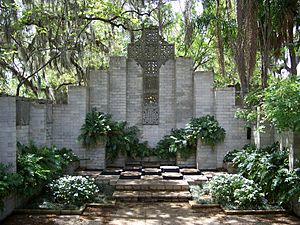
For a few years, she lived and worked in Florida. She stayed at the Research Institute, now called the Maitland Art Center. Her artworks were shown at the Research Studio Gallery in 1940.
Later Career and Recognition
Sparhawk-Jones supported the art shows of Horace Pippin. He was a self-taught artist. She said of him: "For me he is one of the few real artists in our century."
In a 1940 book, Sparhawk-Jones was named one of Pennsylvania's "important young artists." Another book called her a talented woman painter, alongside Cecilia Beaux. She successfully restarted her career in the 1940s, creating modern artworks. During this time, she lived in Philadelphia. Sparhawk-Jones has been especially popular in Chicago and Philadelphia.
In 1940, she combined watercolor and oil in her painting The Generations. The artist Marsden Hartley praised her talent. He said her pictures were "exceptionally forceful" and different from other artists' work. He called her "a thinking painter with a rare sense of the drama."
She painted with watercolor in the 1940s. One of these works is The Dreamer. This painting is now in the Delaware Art Museum. Its design is similar to Michelangelo's The Dream (around 1533).
In 1944, an American Artist magazine article called her a "phenomenon." The author wondered why she wasn't more widely known. Some believe there was a "glass ceiling" for women artists at that time. This made it harder for them to become very famous. For example, a critic found that modern women painters made up only 5% of the paintings in the Museum of Modern Art's collection. This museum does have one of her paintings, Startled Woman. Other ideas for why she wasn't more famous include that she didn't promote her art. Also, she sometimes destroyed paintings when she was unwell. Her periods of mental illness might also have caused some people not to take her as seriously.
An exhibition of her watercolor paintings was held at PAFA in April 1948. From the mid-1950s to the mid-1960s, she lived and enjoyed painting in Paris. She stayed at the Saint Roman hotel, near the Tuileries Garden and the Louvre museum. Her work was featured in a story in the New Mexico Quarterly in 1954. In the 1960s, Sparhawk-Jones was described as an emotional painter. She created spiritual works of art. In 1964, she was interviewed for an oral history project. She won an award for a seascape painting at an art show in New England that same year.
Death and Legacy
Sparhawk-Jones passed away on December 26, 1968, in a hospital in Connecticut. She was buried in the same cemetery as her parents in Immanuel Episcopal Church, Glencoe, Maryland. Her sister was later buried there too.
Information about Sparhawk-Jones' career is kept at the Smithsonian American Art Museum. This includes exhibition catalogs, sketches, and newspaper clippings. In 2010, a book about her life was published. It was called Elizabeth Sparhawk-Jones: The Artist Who Lived Twice.
Collections
The actor Claude Rains collected her artworks. Some of her works in private collections are valued at up to $250,000. Her paintings are also in these public art collections:
- Art Institute of Chicago
- Shoe Shop, c. 1911, oil on canvas
- Shop Girls, c. 1912, oil
- Delaware Art Museum – The Dreamer, c. 1942, tempora on board
- Metropolitan Museum of Art – Caryatides, 1940 watercolor on linen
- Museum of Modern Art – Startled Woman, c. 1956, oil on canvas
- Pennsylvania Academy of the Fine Arts
- The Market, before 1909, oil
- Woman with Fish, 1936 or 1937, oil on canvas
- Whitney Museum of American Art – The Sea Claims its Own, 1961, oil on canvas
- Wichita Art Museum – The Generations, c. 1942, watercolor and oil on silk
Images for kids
-
Lilla Cabot Perry, Edwin Arlington Robinson, 1916, Colby College Special Collections, Waterville, Maine
-
Main House, MacDowell Colony, Peterborough, New Hampshire
-
Research Institute, now Maitland Art Center, Maitland, Florida
-
Francisco Goya's Capricho 43: The Sleep of Reason Produces Monsters, 1799, Museum of Fine Arts, Budapest
See also
 In Spanish: Elizabeth Sparhawk-Jones para niños
In Spanish: Elizabeth Sparhawk-Jones para niños


